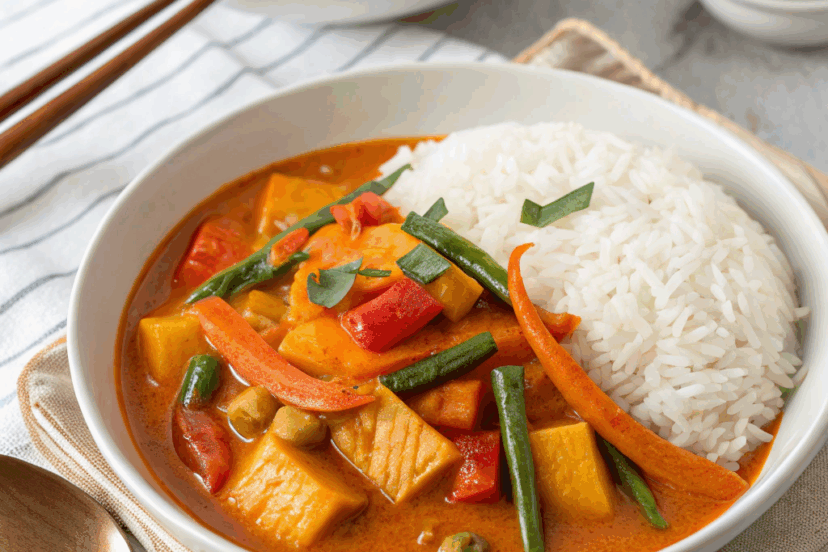Vegetarian Chinese Curry | Instant One-Pot Recipe
Have you ever craved that delicious, aromatic chinese curry from your favorite chinese takeaway but wanted a meat-free version? I’ve spent years perfecting my vegetarian chinese curry recipe, and today I’m sharing my instant one-pot method that rivals any restaurant dish. This vegetarian chinese curry is packed with vibrant vegetables, firm tofu, and an authentic curry sauce that will transport your taste buds straight to China.
The Rich History of Chinese Curry
Origins and Evolution
Chinese curry has a fascinating history that reflects cultural exchange between nations. Unlike Indian curries, Chinese curry developed after curry powder was introduced to China through trading with British merchants in the late 19th century. The Chinese adapted this spice blend to suit their own cooking techniques and flavor preferences.
Traditional Chinese curry tends to be milder than its indian counterparts, often featuring a smooth sauce thickened with cornflour slurry. Over time, regional variations emerged across China, with some areas incorporating local ingredients and cooking methods.
Cultural Significance
In Chinese food tradition, curry represents a perfect balance of flavors and textures. It has become a staple in Chinese cuisine, particularly in Hong Kong-style cafes and northern regions. The dish symbolizes the Chinese approach to adopting foreign influences while maintaining their culinary identity.
Today, vegetarian Chinese curry is growing in popularity as more people embrace plant-based diets without wanting to sacrifice flavor. This adaptation preserves the authentic taste while aligning with modern dietary preferences.
Key Ingredients for Authentic Vegetarian Chinese Curry
The Perfect Curry Base
The heart of any good Chinese curry recipe lies in its sauce. A quality mild curry powder forms the foundation, but what makes Chinese curry distinctive is the addition of star anise, which adds a subtle licorice note that’s unmistakably Chinese. I recommend using Malaysian curry powder if you can find it, as its flavor profile is closer to what you’ll find in authentic Chinese curries.
For the liquid base, vegetable stock provides depth while coconut milk adds richness. Some Chinese curry sauce recipes call for coconut cream for an even more luxurious texture, but I find that regular coconut milk strikes the perfect balance between flavor and lightness.
Protein Choices
Firm tofu is the traditional protein choice for vegetarian Chinese curry. I recommend pressing it first to remove excess moisture, then either cubing it or turning it into crispy tofu by frying before adding to the curry. For variation, tofu puffs make an excellent alternative, absorbing the curry sauce beautifully.
For those looking for different textures, mock meats or gluten balls can be excellent substitutes that provide a heartier bite.
Vegetable Selection
The beauty of this vegetable curry lies in its versatility. Traditional vegetables include:
- Button mushrooms
- Baby corn
- Water chestnuts
- Snow peas
- Green beans
- Bamboo shoots
- Broccoli florets
For a more substantial curry, sweet potatoes or regular potatoes make good choices. Red bell pepper and green bell peppers add beautiful color and sweetness, while long beans provide texture.
Complete Vegetarian Chinese Curry Recipe
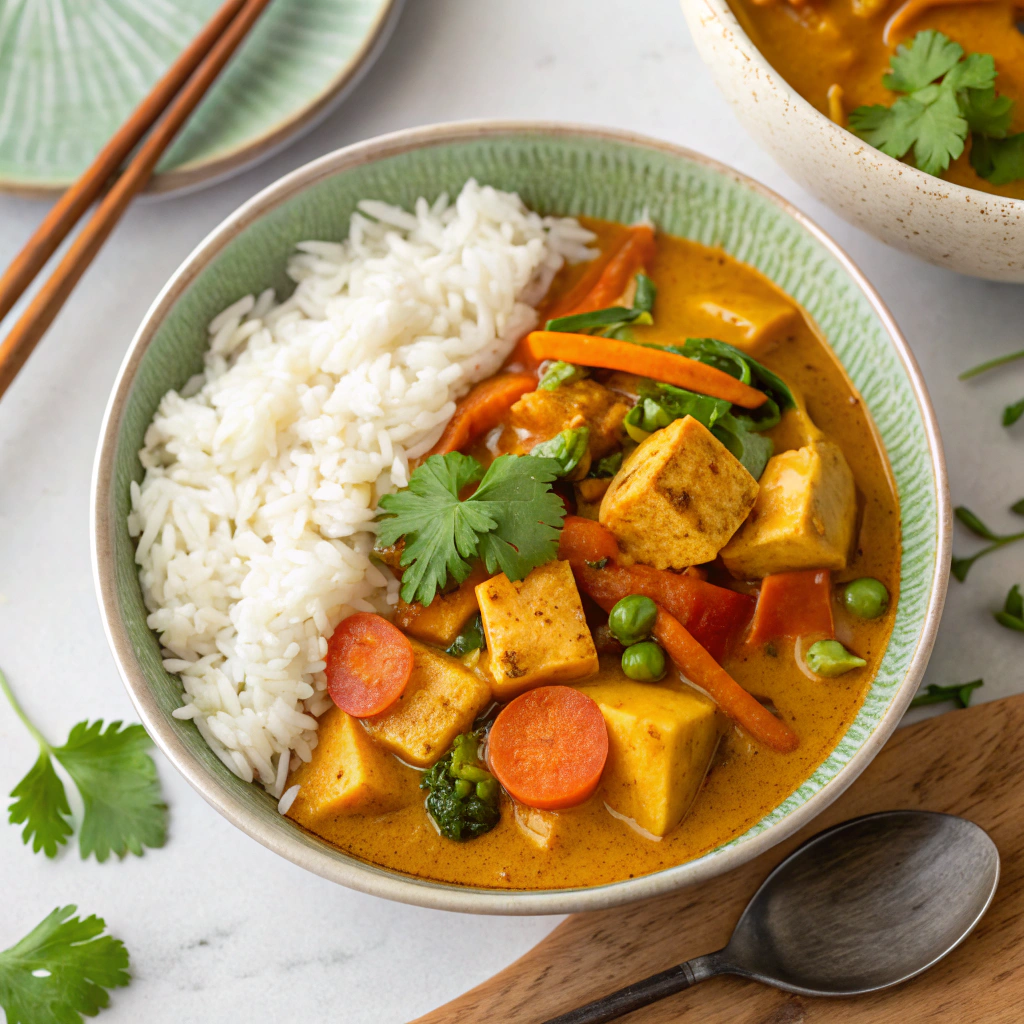
Equipment List
- Large wok or large skillet
- Tofu press
- Wooden spoon
- Small saucepan or rice cooker (for rice)
- Measuring cups and spoons
- Sharp knife and cutting board
- Mixing bowl (for cornflour slurry)
Ingredients for Vegetarian Chinese Curry
For the Curry Sauce:
- 2 tablespoons vegetable oil
- 1 white onion, finely diced
- 3 cloves garlic, minced
- 1 inch ginger, grated
- 2 tablespoons mild curry powder
- 1 teaspoon Chinese curry powder
- 1 star anise
- 2 black peppercorns
- 3 cups vegetable stock or veg stock
- 1/2 cup coconut milk
- 1 tablespoon soy sauce
- 2 tablespoons cornflour mixed with 3 tablespoons of water (cornflour slurry)
For the Vegetables and Tofu:
- 1 block (400g) firm tofu, pressed and cubed
- 1 cup button mushrooms, quartered
- 1 red bell pepper, sliced
- 1 cup baby corn, halved
- 1/2 cup water chestnuts, sliced
- 1/2 cup snow peas
- 1/2 cup bamboo shoots
- 1/2 cup green beans, trimmed and halved
Preparation Time:
- Prep Time: 20 minutes
- Cook Time: 25 minutes
- Total Time: 45 minutes
- Servings: 4
Nutritional Information (Per Serving):
- Calories: 320
- Protein: 15g
- Carbohydrates: 28g
- Fat: 18g
- Fiber: 6g
- Sodium: 680mg
Step-by-Step Instructions for Vegetarian Chinese Curry
1. Prepare the Tofu
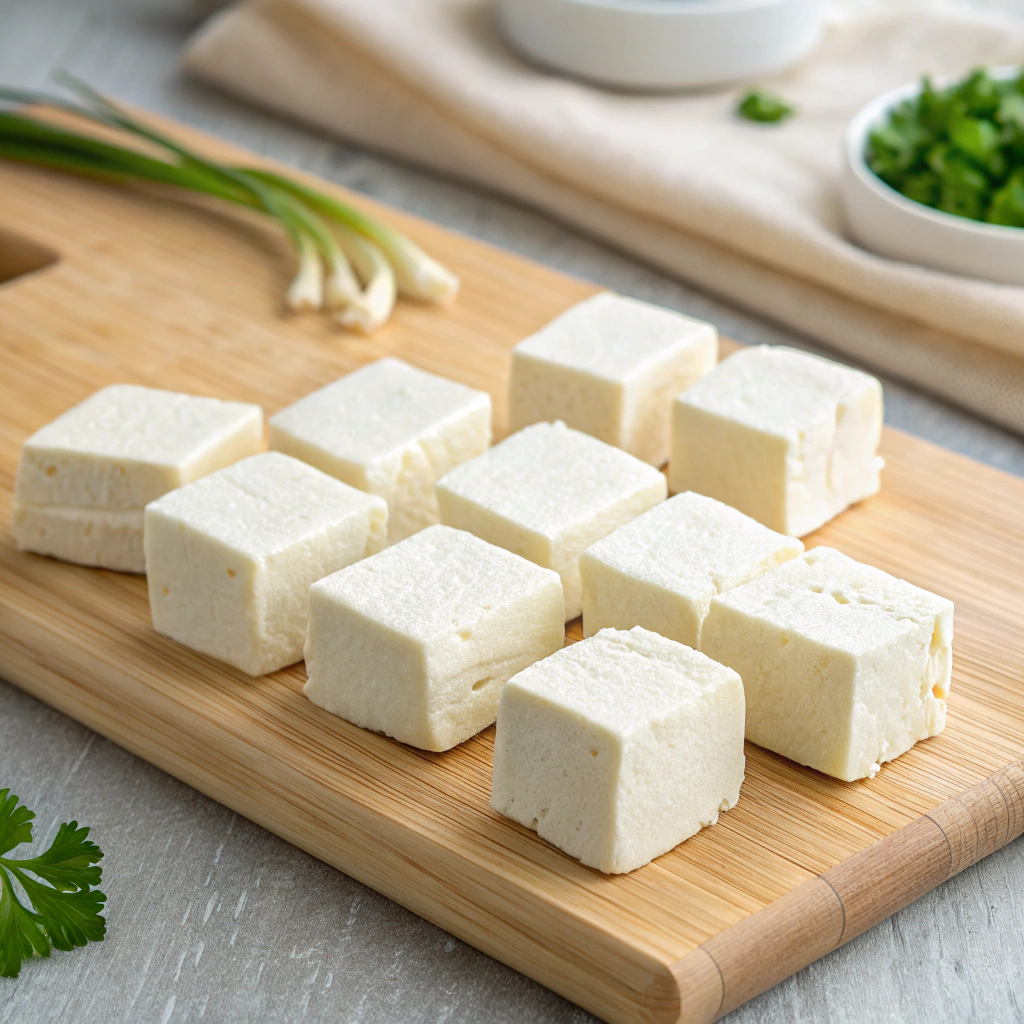
- Press your firm tofu for 30 minutes to remove excess moisture.
- Cut into 1-inch cubes.
- Heat 1 tablespoon of vegetable oil in your large wok over medium heat.
- Add tofu cubes and fry for 5-6 minutes, turning occasionally until golden on all sides.
- Remove and set aside.
2. Create the Curry Base
- In the same wok, add the remaining oil.
- Add diced white onion and sauté for 2-3 minutes until translucent.
- Add minced garlic and grated ginger, cooking for another minute until fragrant.
- Add mild curry powder, Chinese curry powder, star anise, and black peppercorns.
- Stir continuously for 1 minute to toast the spices and prevent burning.
3. Make the Curry Sauce
- Slowly pour in vegetable stock, stirring constantly to prevent lumps.
- Add coconut milk and soy sauce, stirring to combine.
- Bring to a gentle simmer and cook for 5 minutes.
- In a small bowl, mix cornflour with cold water to create a slurry.
- Slowly pour the cornflour slurry into the simmering sauce, stirring constantly.
- Continue cooking for 2-3 minutes until the sauce thickens.
4. Add Vegetables and Tofu

- Add harder vegetables first (bell peppers, baby corn, water chestnuts).
- Cook for 3 minutes, then add quicker-cooking vegetables (mushrooms, snow peas, green beans, bamboo shoots).
- Simmer for a couple of minutes until vegetables are tender-crisp.
- Gently fold in the fried tofu.
- Simmer for another 2-3 minutes to allow flavors to meld.
5. Serve
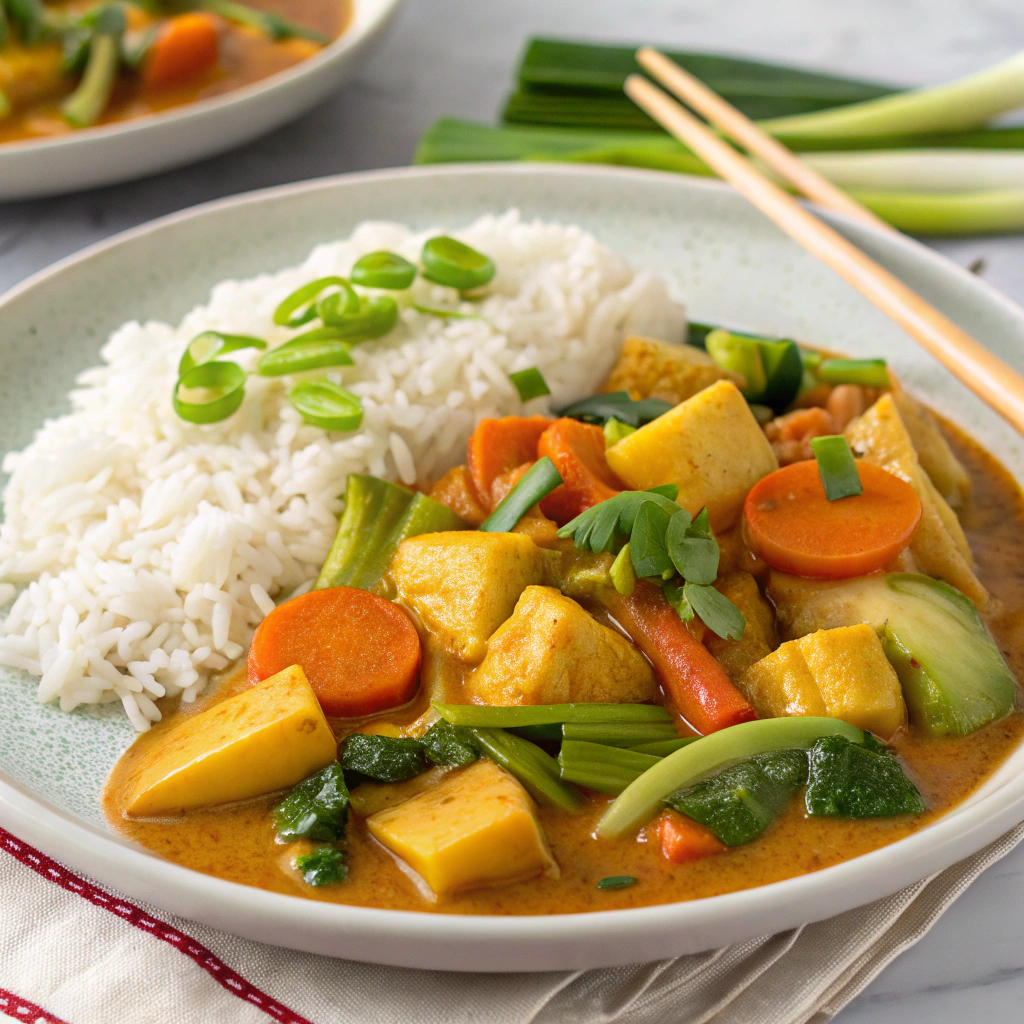
- Remove the star anise.
- Taste and adjust seasoning if necessary.
- Serve hot over steamed jasmine rice or rice vermicelli.
Dietary Adaptations for Vegetarian Chinese Curry
Vegan Chinese Curry Version
This recipe is already vegan-friendly, as it uses vegetable stock and coconut milk instead of animal products. Just double-check that your curry powder doesn’t contain any animal derivatives, which is rare but possible.
Gluten-Free Vegetarian Chinese Curry
To make this curry gluten-free:
- Replace soy sauce with tamari or gluten-free soy sauce.
- Ensure your curry powder and vegetable stock are certified gluten-free.
- Use cornflour (cornstarch), which is naturally gluten-free, for thickening.
Low-Calorie Vegetarian Chinese Curry
For a lighter version:
- Use light coconut milk instead of regular.
- Reduce oil to 1 tablespoon.
- Increase the proportion of vegetables to tofu.
No Onion-No Garlic Vegetarian Chinese Curry
For those following Jain, certain Buddhist, or other dietary restrictions that avoid onions and garlic:
- Replace white onion with asafoetida (hing) – use just a pinch (about 1/4 teaspoon) bloomed in hot oil at the start of cooking.
- Substitute garlic with ginger – double the amount of ginger to compensate for flavor.
- Add 1 tablespoon of celery or fennel seeds, lightly crushed, for aromatic depth.
- Include an extra tablespoon of curry powder to enhance flavor complexity.
- Finish with a squeeze of fresh lemon juice to brighten the dish and add dimension that would typically come from alliums.
This adaptation maintains the soul of Chinese curry while respecting dietary restrictions. The asafoetida provides a similar aromatic base, while the additional ginger and spices ensure the curry remains flavorful and balanced.
Variations and Additions for Vegetarian Chinese Curry
Spice Level Adjustments
For a spicier curry, add:
- 1 teaspoon chili powder
- 1 fresh chili, finely chopped
- A dash of hot water with chili oil
For a milder version:
- Reduce curry powder to 1 tablespoon
- Add an extra splash of coconut milk
Alternative Protein Options for Vegetarian Chinese Curry
Beyond tofu, consider:
- Seitan or tempeh
- Paneer (for vegetarians who consume dairy)
- Chickpeas or other legumes
- Mock meats like vegetarian chicken pieces
- Soya chunks
Regional Variations
Hong Kong Style
Add 1 tablespoon of tomato paste and 1 teaspoon of sugar for a slightly sweet and tangy curry sauce typical of Hong Kong cuisine.
Szechuan Influence
Include 1 tablespoon of fermented bean paste and Szechuan peppercorns for a numbing, spicy twist.
Thai-Chinese Fusion
Replace regular curry powder with green curry paste and add extra lemongrass and lime leaves for a Southeast Asian flair.
Top Tips for Perfect Vegetarian Chinese Curry
Getting the Right Consistency
The perfect chinese curry sauce should coat the back of a spoon but still flow smoothly. If your sauce is too thick, add small amounts of hot water until you reach the desired consistency. If it’s too thin, mix a little more cornflour with cold water and add it gradually.
Vegetable Cooking Times
Different vegetables require different cooking times. Here’s a quick guide:
- Longer cooking (5-6 minutes): Sweet potatoes, regular potatoes, carrots
- Medium cooking (3-4 minutes): Bell peppers, broccoli florets, green beans
- Quick cooking (1-2 minutes): Snow peas, bean sprouts, leafy greens
Balancing Flavors
Chinese cuisine is all about balance. If your curry tastes:
- Too spicy: Add more coconut milk
- Too bland: Add a touch more soy sauce or salt
- Too thick: Add a splash of vegetable stock
- Too thin: Use more cornflour slurry
Vegetarian Chinese Curry Make-Ahead and Storage
This curry actually tastes better the next day as the flavors have time to develop. Store in an airtight container in the refrigerator for up to 3 days. When reheating, add a splash of water if the sauce has thickened too much.
For meal prep, you can freeze portions for up to 3 months. Thaw overnight in the refrigerator before reheating.
Serving Suggestions for Vegetarian Chinese Curry
Traditional Accompaniments
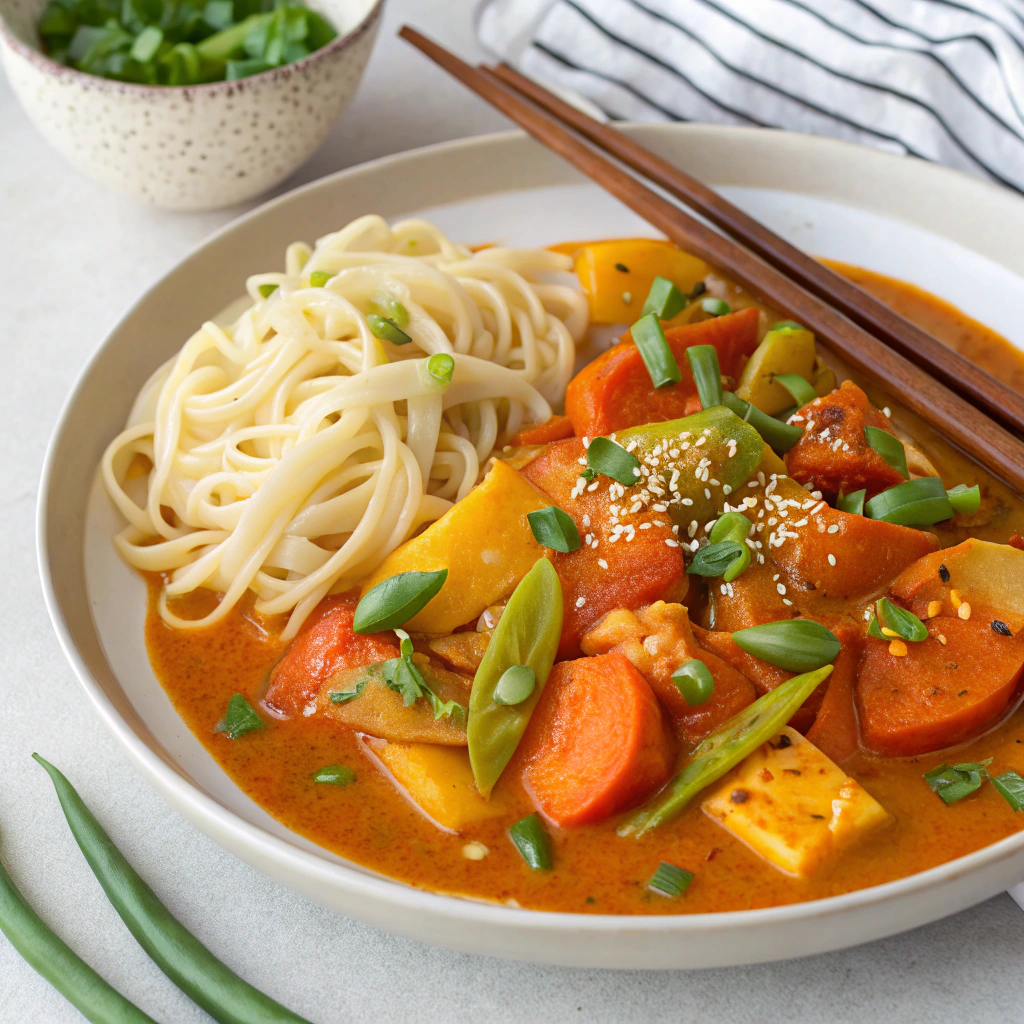
- Steamed jasmine rice is the classic pairing for Chinese curry
- For a different texture, try rice vermicelli or egg noodles
- Chinese greens like bok choy or gai lan make perfect side dishes
Modern Twists

- Serve in a bread bowl for a fusion approach
- Create curry bao buns by filling steamed mantou with curry
- Use as a dipping sauce for spring rolls or dumplings
Garnishes and Toppings for Vegetarian Chinese Curry
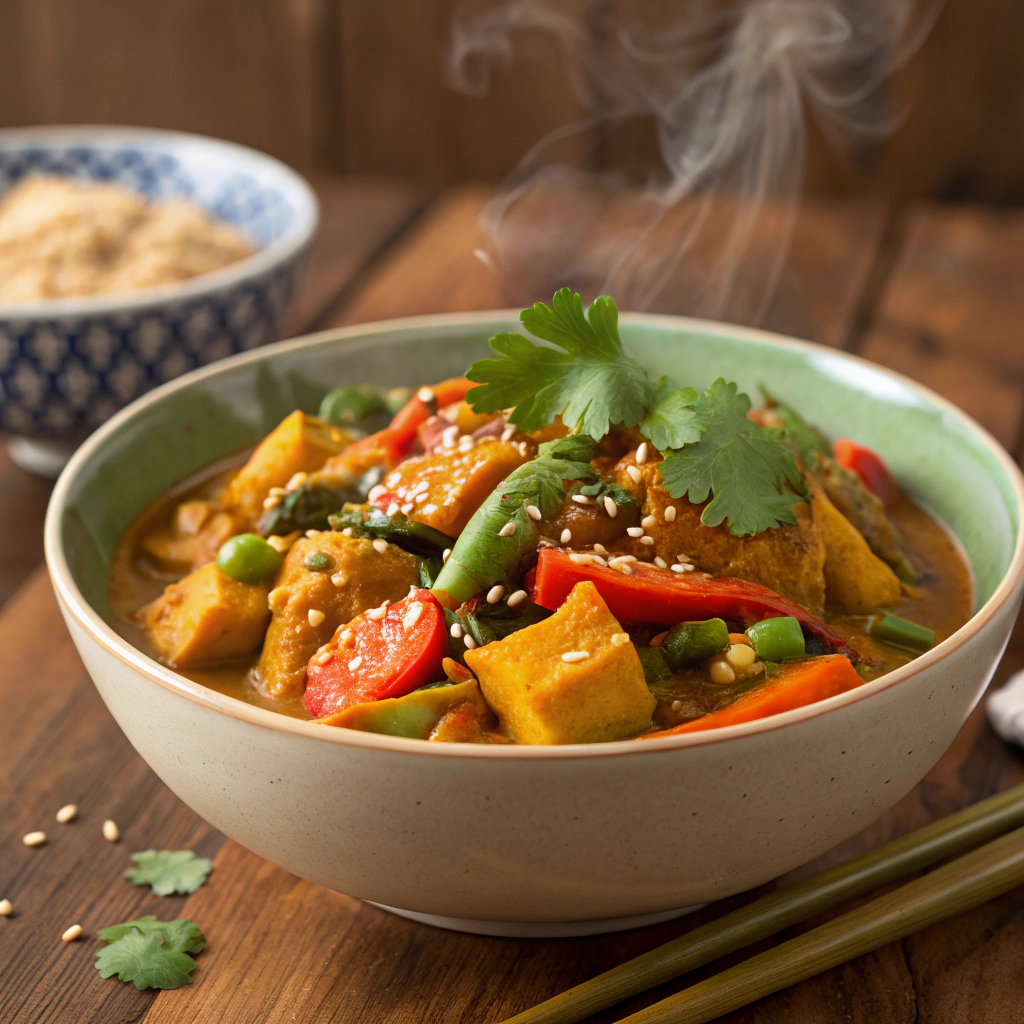
Elevate your vegetarian Chinese curry with:
- Sliced spring onions
- Fresh cilantro leaves
- Toasted sesame seeds
- Crispy fried shallots
- A drizzle of chili oil for heat lovers
Why This Vegetarian Chinese Curry Recipe Works
What makes this vegetarian Chinese curry special is its authenticity despite being meat-free. The combination of traditional Chinese curry spices with the perfect cooking technique creates a dish that’s every bit as satisfying as its meat-containing counterpart.
The one-pot approach means less cleanup, while the instant cooking method preserves the vibrant colors and nutrients of the vegetables. The cornflour slurry gives the sauce that distinctive Chinese curry consistency that’s thick enough to coat your vegetables but not so thick that it becomes stodgy.
Additionally, the balance of protein from tofu, complex carbohydrates from rice, and fiber from vegetables makes this a nutritionally complete meal that satisfies without weighing you down.
Common Mistakes to Avoid When Cooking Vegetarian Chinese Curry
Overcooking Vegetables
The most common mistake is adding all vegetables at once and cooking them too long. This results in mushy vegetables that lose their color and nutrients. Instead, add them in stages according to their cooking times.
Using Cold Oil
Always heat your wok or large pot before adding oil, and heat the oil before adding ingredients. This prevents sticking and helps achieve the proper stir fry effect.
Skipping the Toasting Step
Toasting curry powder in oil releases its essential oils and deepens its flavor. Don’t skip this crucial step, but be careful not to burn the spices.
Using a Small Pan
Chinese curry benefits from being cooked in a large wok or skillet. Crowding ingredients in a small saucepan leads to steaming rather than proper sautéing.
Conclusion
Vegetarian Chinese curry is a delicious meal that brings together the best of Chinese cooking techniques with the aromatic flavors of curry. This one-pot recipe allows you to create an authentic Chinese takeaway experience right in your own kitchen, with the added benefits of being healthier and customizable to your preferences.
Whether you’re a committed vegetarian, exploring plant-based cooking, or simply looking for a delicious meatless Monday option, this curry delivers on flavor, texture, and satisfaction. The combination of firm tofu and vibrant vegetables in a silky, aromatic sauce creates a perfect balance that will have you reaching for seconds.
By mastering this vegetarian Chinese curry recipe, you’re not just learning to cook a dish—you’re embracing a culinary tradition that spans cultures and generations. So grab your wok, gather your ingredients, and get ready to create a meal that will impress even the most dedicated curry connoisseurs.
Explore Related Recipes
Easy Chinese Claypot Tofu With Mushrooms (Vegan)
Easy Hunan Tofu Recipe | Vegan & Hot Chinese Food
Vegan Tofu Banh Mi Recipe (Vietnamese Sandwich)
Eggplant Tofu Recipe (Vegan, Gluten-Free, Healthy)
Mouth-Watering Vegan Soup Dumplings Recipe
FAQs About Vegetarian Chinese Curry
1. What makes Chinese curry different from Indian or Thai curries?
Chinese curry tends to be milder and smoother than Indian or Thai versions. It typically uses mild curry powder rather than a curry paste, includes star anise for that distinctive Chinese flavor, and is thickened with cornflour slurry to create a silky sauce. The cooking technique also differs, with Chinese curry often starting with a quick stir fry before simmering.
2. Can I make this vegetarian Chinese curry recipe in advance for a party?
Yes! In fact, vegetarian Chinese curry often tastes better the next day as the flavors have time to develop. Make it up to two days in advance and store in the refrigerator in an airtight container. When ready to serve, reheat gently on the stove, adding a splash of water or vegetable stock if the sauce has thickened too much.
3. I don’t have a wok. Can I still make this curry?
Yes, while a wok is traditional and ideal for the quick stir-frying portion of the recipe, any large skillet or pot with high sides will work. The key is having enough space to stir-fry the vegetables without crowding them, which would cause them to steam rather than sauté.
4. How spicy is this vegetarian Chinese curry, and how can I adjust the heat level?
This recipe creates a mild to medium heat curry, similar to what you’d find in most Chinese restaurants. To make it spicier, add chili powder or fresh chilies. For a milder version, reduce the amount of curry powder and increase the coconut milk. Different brands of curry powder vary in spiciness, so adjust according to your preference.
5. Can I add different vegetables than those listed in the recipe?
Of course! One of the best things about vegetarian Chinese curry is its versatility. Feel free to use whatever vegetables you have on hand or are in season. Just remember to add harder vegetables first and more delicate ones toward the end of cooking to ensure everything is perfectly cooked. Extra veggies like cauliflower, zucchini, or eggplant make excellent additions to this flexible recipe.
Printable Recipe Card

Vegetarian Chinese Curry | Instant One-Pot Recipe
Equipment
- Large wok or large skillet
- Small saucepan (for rice)
- Sharp knife and cutting board
- Mixing bowl (for cornflour slurry)
Ingredients
For the Curry Sauce:
- 2 tablespoons vegetable oil
- 1 white onion finely diced
- 3 cloves garlic minced
- 1 inch ginger grated
- 2 tablespoons mild curry powder
- 1 teaspoon Chinese curry powder
- 1 star anise
- 2 black peppercorns
- 3 cups vegetable stock or veg stock
- 1/2 cup coconut milk
- 1 tablespoon soy sauce
- 2 tablespoons cornflour mixed with 3 tablespoons of water cornflour slurry
For the Vegetables and Tofu:
- 1 block 400g firm tofu, pressed and cubed
- 1 cup button mushrooms quartered
- 1 red bell pepper sliced
- 1 cup baby corn halved
- 1/2 cup water chestnuts sliced
- 1/2 cup snow peas
- 1/2 cup bamboo shoots
- 1/2 cup green beans trimmed and halved
Instructions
Prepare the Tofu
- Press your firm tofu for 30 minutes to remove excess moisture.
- Cut into 1-inch cubes.
- Heat 1 tablespoon of vegetable oil in your large wok over medium heat.
- Add tofu cubes and fry for 5-6 minutes, turning occasionally until golden on all sides.
- Remove and set aside.
Create the Curry Base
- In the same wok, add the remaining oil.
- Add diced white onion and sauté for 2-3 minutes until translucent.
- Add minced garlic and grated ginger, cooking for another minute until fragrant.
- Add mild curry powder, Chinese curry powder, star anise, and black peppercorns.
- Stir continuously for 1 minute to toast the spices and prevent burning.
Make the Curry Sauce
- Slowly pour in vegetable stock, stirring constantly to prevent lumps.
- Add coconut milk and soy sauce, stirring to combine.
- Bring to a gentle simmer and cook for 5 minutes.
- In a small bowl, mix cornflour with cold water to create a slurry.
- Slowly pour the cornflour slurry into the simmering sauce, stirring constantly.
- Continue cooking for 2-3 minutes until the sauce thickens.
Add Vegetables and Tofu
- Add harder vegetables first (bell peppers, baby corn, water chestnuts).
- Cook for 3 minutes, then add quicker-cooking vegetables (mushrooms, snow peas, green beans, bamboo shoots).
- Simmer for a couple of minutes until vegetables are tender-crisp.
- Gently fold in the fried tofu.
- Simmer for another 2-3 minutes to allow flavors to meld.
Serve
- Remove the star anise.
- Taste and adjust seasoning if necessary.
- Serve hot over steamed jasmine rice or rice vermicelli.
Notes
- Longer cooking (5-6 minutes): Sweet potatoes, regular potatoes, carrots
- Medium cooking (3-4 minutes): Bell peppers, broccoli florets, green beans
- Quick cooking (1-2 minutes): Snow peas, bean sprouts, leafy greens
- Too spicy: Add more coconut milk
- Too bland: Add a touch more soy sauce or salt
- Too thick: Add a splash of vegetable stock
- Too thin: Use more cornflour slurry

